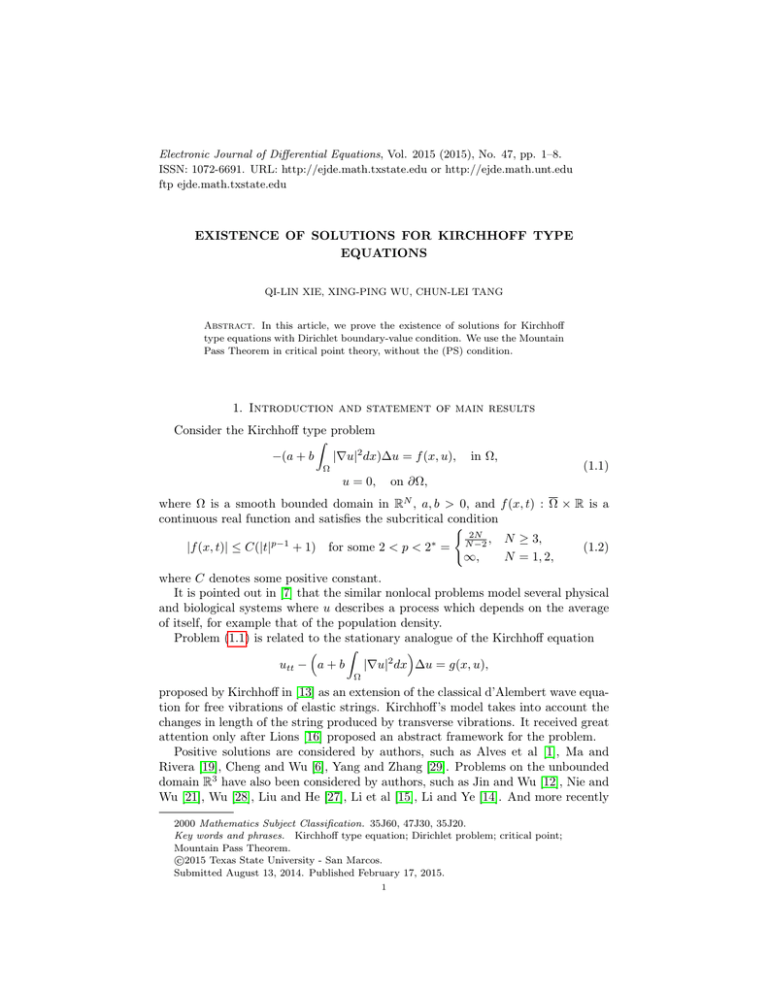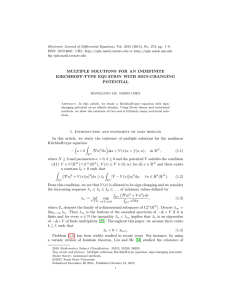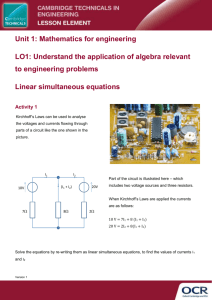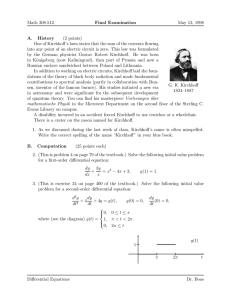Electronic Journal of Differential Equations, Vol. 2015 (2015), No. 47,... ISSN: 1072-6691. URL: or
advertisement

Electronic Journal of Differential Equations, Vol. 2015 (2015), No. 47, pp. 1–8.
ISSN: 1072-6691. URL: http://ejde.math.txstate.edu or http://ejde.math.unt.edu
ftp ejde.math.txstate.edu
EXISTENCE OF SOLUTIONS FOR KIRCHHOFF TYPE
EQUATIONS
QI-LIN XIE, XING-PING WU, CHUN-LEI TANG
Abstract. In this article, we prove the existence of solutions for Kirchhoff
type equations with Dirichlet boundary-value condition. We use the Mountain
Pass Theorem in critical point theory, without the (PS) condition.
1. Introduction and statement of main results
Consider the Kirchhoff type problem
Z
−(a + b
|∇u|2 dx)∆u = f (x, u),
in Ω,
Ω
u = 0,
(1.1)
on ∂Ω,
where Ω is a smooth bounded domain in RN , a, b > 0, and f (x, t) : Ω × R is a
continuous real function and satisfies the subcritical condition
(
2N
, N ≥ 3,
p−1
∗
(1.2)
|f (x, t)| ≤ C(|t|
+ 1) for some 2 < p < 2 = N −2
∞,
N = 1, 2,
where C denotes some positive constant.
It is pointed out in [7] that the similar nonlocal problems model several physical
and biological systems where u describes a process which depends on the average
of itself, for example that of the population density.
Problem (1.1) is related to the stationary analogue of the Kirchhoff equation
Z
utt − a + b
|∇u|2 dx ∆u = g(x, u),
Ω
proposed by Kirchhoff in [13] as an extension of the classical d’Alembert wave equation for free vibrations of elastic strings. Kirchhoff’s model takes into account the
changes in length of the string produced by transverse vibrations. It received great
attention only after Lions [16] proposed an abstract framework for the problem.
Positive solutions are considered by authors, such as Alves et al [1], Ma and
Rivera [19], Cheng and Wu [6], Yang and Zhang [29]. Problems on the unbounded
domain R3 have also been considered by authors, such as Jin and Wu [12], Nie and
Wu [21], Wu [28], Liu and He [27], Li et al [15], Li and Ye [14]. And more recently
2000 Mathematics Subject Classification. 35J60, 47J30, 35J20.
Key words and phrases. Kirchhoff type equation; Dirichlet problem; critical point;
Mountain Pass Theorem.
c
2015
Texas State University - San Marcos.
Submitted August 13, 2014. Published February 17, 2015.
1
2
Q.-L. XIE, X.-P. WU, C.-L. TANG
EJDE-2015/47
the concentration behavior of positive solutions has been studied by He and Zou
[9], Wang et al [26], He et al [11]. A result with Hartree-type nonlinearities can be
found in Lü [18]. Ground state nonlinear with critical growth is considered in He
and Zou [10]. The readers may consult Bernstein [2] and Pohožaev [23], Sun and
Tang [24], Chen et al [4], Cheng [5], Perera and Zhang [22, 31], Mao and Zhang [20],
Sun and Liu [25] and the references therein, for more information on this problem.
There are many solvability conditions for problem (1.1) with f , like the asymptotical linear case (at infinity) in [29] and people are more interested in the superlinear
case (at infinity):
(S1) there exists θ ≥ 1 such that θG(t) ≥ G(st) for all t ∈ R and s ∈ [0, 1],
where G(t) = f (t)t − 4F (t) (see [24]);
(S2) lim|t|→∞ G(t) = ∞ and there exist σ > max{1, N/2} and C > 0 such that
|f (t)|σ ≤ CG(t)|t|σ for |t| large (see [20]); or some limitation forms,
(S3) lim|t|→∞ [f (t)t − 4F (t)] = ∞ (see [30]);
(x,t)
> −α uniformly in x ∈ Ω, where τ ∈ [0, 2] and
(S4) lim inf |t|→∞ f (x,t)t−4F
|t|τ
0 < α < aλ1 , λ1 is the first eigenvalue of − ∆, H01 (Ω) (see [5]).
All kinds of conditions are mainly making sure the boundness of the Cerami or
Palais-Smale sequences. The following condition on f which is called AmbrosettiRabinowitz condition is often used:
(S5) there exists θ > 4 such that f (x, t)t ≥ θF (x, t) for |t| large, where F (x, t) =
Rt
f (x, s)ds.
0
We consider the nonlinear eigenvalue problem
Z
|∇u|2 dx ∆u = µu3 , in Ω,
−
(1.3)
Ω
u = 0, on ∂Ω,
whose the eigenvalues are the critical values of the functional
Z
J(u) = kuk4 , u ∈ S := u ∈ H01 (Ω) :
|u|4 dx = 1 ,
(1.4)
Ω
1/2
R
where kuk = Ω |∇u|2 dx
. We already know the first eigenvalue µ1 > 0 and
the first eigenfunction ψ1 > 0 (see [31]).
Now, we can state our main results.
Theorem 1.1. Assume that f ∈ C(Ω × R, R) satisfies (1.2) and
(F1) lim|t|→∞ aλ2 1 t2 + bµ41 t4 − F (x, t) = +∞ uniformly in x ∈ Ω;
2
(F2) there exists λ > λ1 such that F (x, t) ≥ aλ
2 t for |t| small.
Then (1.1) has at least one nontrivial solution.
Remark 1.2. Theorem 1.1 is a new for the case lim inf |t|→∞ F (x,t)
≤ bµ41 . The
t4
condition (F1) is weaker than (F3) in [30]. So our theorem is different from their
theorems and obtains one nontrivial solution by adding the condition (F2) near
zero.
Theorem 1.3. Assume that f ∈ C(Ω × R, R) satisfies (1.2) and
(F3) lim inf |t|→∞ F (x,t)
> bµ41 uniformly in x ∈ Ω;
t4
(F4) lim|t|→∞ 14 f (x, t)t − F (x, t) + aλ4 1 t2 = +∞ uniformly in x ∈ Ω;
4
(F5) there exists µ < µ1 such that F (x, t) ≤ aλ2 1 t2 + bµ
4 t for |t| small.
EJDE-2015/47
EXISTENCE OF SOLUTIONS
3
Then (1.1) has at least one nontrivial solution.
Remark 1.4. Condition (F4) is a new condition for a class of function f (x, t) and
is weaker than (S1)–(S5). For example, let
aλ1 3
4t5
3
4
.
f (x, t) =
8t ln(1 + t2 ) +
+
4t
cos
t
8
1 + t2
A simple computation shows that
1
aλ1 2
aλ1 t6 (1 + cos t4 ) t4 (2 + cos t4 ) + 2t2
4
+
−
sin
t
f (x, t)t − F (x, t) +
t =
4
4
8
1 + t2
1 + t2
and
1
aλ1 2 lim
f (x, t)t − F (x, t) +
t = +∞.
4
|t|→∞ 4
Hence, f (x, t) satisfies all the assumptions of Theorem 1.3, but it does not satisfy
any conditions of (S1)–(S5).
2. Preliminaries
1/2
R
We consider H := H01 (Ω) endowed with the norm kuk = Ω |∇u|2 dx
. We
denote the usual Lp (Ω)-norm by | · |p . Since Ω is a bounded domain, it is well
known that H ,→ Lp (Ω) continuously for p ∈ [1, 2∗ ], and compactly for p ∈ [1, 2∗ ).
Moreover there exists γp > 0 such that
|u|p ≤ γp kuk,
u ∈ H.
(2.1)
Seeking a weak solution of problem (1.2) is equivalent to finding a critical point
of the C 1 functional
Z
b
a
2
4
F (x, u)dx, u ∈ H,
(2.2)
I(u) := kuk + kuk −
2
4
Ω
which implies that
0
2
Z
hI (u), vi = (a + bkuk )
Z
∇u · ∇vdx −
Ω
f (x, u)vdx, u, v ∈ H.
(2.3)
Ω
Let
Ej := ⊕i≤j ker(−∆ − λi ),
where 0 < λ1 ≤ λ2 ≤ λ3 ≤ · · · ≤ λi ≤ . . . are the eigenvalues of (−∆, H). We
denote a subsequence of a sequence {un } as {un } to simplify the notation unless
specified. We need the following concept, which was introduced by Cerami [3] and
is a weak version of the (PS) condition.
Definition 2.1 ([3]). Let J ∈ C 1 (X, R), we say that J satisfies the Cerami condition at the level c ∈ R ((Ce)c for short), if any sequence {un } ⊂ X with
J(un ) → c,
(1 + kun k)J 0 (un ) → 0
as n → ∞,
possesses a convergence subsequence in X; J satisfies the (Ce) condition if J satisfies
the (Ce)c for all c ∈ R.
The following lemma, which can be found in [8], is our main tool in this article.
Lemma 2.2 (Mountain Pass Theorem). Let H be a real Banach space and I ∈
C 1 (H, R) satisfying the (Ce) condition. Suppose I(0) = 0,
4
Q.-L. XIE, X.-P. WU, C.-L. TANG
EJDE-2015/47
(i) there are constants ρ, β > 0 such that I|∂Bρ ≥ β where
Bρ = {u ∈ H : kuk ≤ ρ};
(ii) there is u1 ∈ H and ku1 k > ρ such that I(u1 ) < 0.
Then I possesses a critical value c ≥ β. Moreover c can be characterized as
c = inf
max
g∈Γ u∈g([0,1])
I(u),
Γ = {g ∈ C([0, 1], H) : g(0) = 0, g(1) = u1 }.
We give a lemma about the (Ce) condition which will play an important role in
the proof of our theorems.
Lemma 2.3. Assume that f (x, t) satisfies (1.2) and (F4), then I satisfies the (Ce)
condition.
Proof. Suppose that {un } is a (Ce)c sequence for c ∈ R
I(un ) → c,
(1 + kun k)I 0 (un ) → 0
as n → ∞.
(2.4)
Now firstly, we prove that {un } is a bounded sequence. From (2.2), (2.3) and (2.4),
we obtain
Z a
1
1
f (x, un )un − F (x, un ) dx. (2.5)
1 + c ≥ I(un ) − I 0 (un )un = kun k2 +
4
4
Ω 4
By (F4), there exists M > 0 such that
aλ1 2
1
f (x, t)t − F (x, t) +
|t| ≥ −M
4
4
(2.6)
for all x ∈ Ω and t ∈ R. And let un = φn + wn , where φn ∈ E1 and wn ∈ E1⊥ .
From (2.5) and (2.6), one obtains
1
1 + c ≥ I(un ) − I 0 (un )un
4
Z aλ1
1
aλ1
a
2
2
|un |2 +
f (x, un )un − F (x, un ) +
|un |2 dx (2.7)
= kun k −
4
4
4
Ω 4
a
λ1
≥
1−
kwn k2 − M |Ω|
4
λ2
which implies that kwn k is bounded. We claim that {un } is a bounded sequence.
Otherwise, there is a subsequence of {un } satisfying kun k → +∞ as n → +∞.
Then we obtain
wn
→ 0 ∈ H.
kun k
Since φn /kun k is bounded in E1 (E1 has finite dimension), we have φn /kun k → v
in E1 . By
un
φn + wn
φn
wn
vn :=
=
=
+
→ v ∈ E1 ,
kun k
kun k
kun k kun k
one has
un (x)
→ v(x) a.e. in Ω.
(2.8)
kun k
From kvn k = 1, we obtain that kvk = 1. And by v ∈ E1 , one has that v(x) > 0 or
v(x) < 0, which implies that
|un (x)| → +∞ as n → +∞
(2.9)
EJDE-2015/47
EXISTENCE OF SOLUTIONS
5
for all x ∈ Ω by (2.8). It follows from (2.7), (2.9) and Fatou’s lemma that
1
1 + c ≥ I(un ) − I 0 (un )un
4Z
1
a
2
= kun k +
f (x, un )un − F (x, un ) dx
4
Ω 4
Z aλ1
1
f (x, un )un − F (x, un ) +
|un |2 dx
≥
4
Ω 4
→ +∞ as n → +∞,
which is a contradiction. Then we get that {un } is bounded in H. Since f (x, t) is
subcritical growth, we can easily obtain that {un } has a convergence subsequence.
Hence, I satisfies the (Ce) condition.
3. Proof of main results
Proof of Theorem 1.1. Let
Z
∇u · ∇φ1 dx φ1 ,
u=
u
e = u − u,
Ω
where the φ1 is the first eigenfunction corresponding to λ1 .
The following statements come from [17]. First, there exist a real function g ∈
L1 (Ω), and G ∈ C(R, R) which is subadditive; that is,
G(s + t) ≤ G(s) + G(t)
for all s, t ∈ R, and coercive; that is, G(t) → +∞ as |t| → ∞, and satisfies
G(t) ≤ |t| + 4
for all t ∈ R, such that
F (x, t) −
aλ1 2 bµ1 4
t −
t ≤ −G(t) + g(x)
2
4
for all t ∈ R and x ∈ Ω. R
Second, the functional Ω G(v)dx is coercive on E1 (this result also can be seen
in [17]). We claim that I(u) is coercive.
Z aλ1 2 bµ1 4 F (x, u) −
u −
u dx
2
4
Ω
Z
Z
≤−
G(u)dx +
g(x)dx
Ω
Z
ZΩ
u)) dx +
g(x)dx
≤−
(G(u) − G(−e
Ω
ZΩ
Z
≤−
G(u)dx + |e
u|1 + 4|Ω| +
g(x)dx
Ω
ZΩ
≤−
G(u)dx + C1 (ke
uk + 1)
Ω
for all u ∈ H and some
Z
C1 = C + 4|Ω| +
g(x)dx,
Ω
where C is a positive constant in Sobolev’s inequality,
|u|1 ≤ Ckuk,
|u|2 ≤ Ckuk
6
Q.-L. XIE, X.-P. WU, C.-L. TANG
EJDE-2015/47
for all u ∈ H. Hence we have
Z
a
b
I(un ) = kuk2 + kuk4 −
F (x, u)dx
2
4
Ω
aλ1
b
bµ1
a
|un |22 + kun k4 −
|un |44
= kun k2 −
2Z
2
4
4
aλ
bµ1
1
+
|un |2 +
|un |4 − F (x, un ) dx
2
4
Ω
Z a
aλ
bµ1
aλ1
1
2
2
≥ kun k −
|un |2 +
|un |2 +
|un |4 − F (x, un ) dx
2
2
2
4
Ω
Z
λ1
a
1−
ke
uk2 +
uk + 1)
G(u)dx − C1 (ke
≥
2
λ2
Ω
R
for all u ∈ H. By the coercivity of the functional Ω G(v)dx on E1 and that fact
kuk2 = kuk2 + ke
uk2 ,
which implies that the functional I(u) is coercive. I satisfies the (Ce) condition
and is bounded from below. By (F2), we have
aλ 2
t − C|t|p
2
for all x ∈ Ω and t ∈ R, which implies that
F (x, t) ≥
a
b
aλ 2
kuk2 + kuk4 −
|u|2 + C|u|pp
2
4
2
a
λ
b
=
1−
kuk2 + kuk4 + Ckukp < 0
2
λ1
4
I(u) ≤
for u ∈ E1 ∩ Bδ , λ > λ1 , where δ > 0 small enough and E1 is the subspace of H
spanned by φ1 the eigenfunctions of λ1 . Then I(u) achieves the negative infimum.
This completes the proof
Proof of Theorem 1.3. By Lemmas 2.2 and 2.3, it is sufficient to show that I satisfies (i) and (ii).
Step 1. There are constants ρ, β > 0 such that I(u) ≥ β for all kuk = ρ. In fact,
by (F5), it is easy to see that
F (x, t) ≤
aλ1 2 b(µ1 − ε) 4
t +
t + C|t|p
2
4
for all t ∈ R and x ∈ Ω,
a
b
aλ1 2 b(µ1 − ε) 4
kuk2 + kuk4 −
|u|2 −
|u|4 − C
2
4
2
4
b
µ1 − ε ≥ 1−
kuk4 − Cγp kukp .
4
µ1
Z
I(u) ≥
|u|p dx
Ω
Note that 4 < p < 2∗ , then for ε small enough. So there exists β > 0 such that
I(u) ≥ β for all kuk = ρ, where ρ > 0 small enough.
Step 2. There exists u1 ∈ H and ku1 k > ρ such that I(u1 ) < 0. Indeed, for small
ε > 0, by the definition of µ1 , we can choose u ∈ S satisfying
ε
µ1 + ≥ kuk4 .
(3.1)
2
EJDE-2015/47
EXISTENCE OF SOLUTIONS
7
It follows from (F3) that
F (x, t) ≥
b(µ1 + ε) 4
t − C.
4
(3.2)
Hence, by (3.1) and (3.2), we have
a 2
b
b
t kuk2 + t4 kuk4 − t4 (µ1 + ε) + C|Ω|
2
4
4
b
bε
b
a
≤ t2 kuk2 + t4 µ1 + t4 − t4 (µ1 + ε) + C|Ω|
2
4
8
4
bε
a
= − t4 + t2 kuk2 + C|Ω|.
8
2
I(tu) ≤
(3.3)
Thus, I(tu) → −∞ as t → ∞. Therefore, there is u1 ∈ H with ku1 k > ρ such that
I(u1 ) < 0. This completes the proof.
Acknowledgements. The authors would like to thank the anonymous referees
and the editors for their valuable suggestions.
This research was supported by National Natural Science Foundation of China
(No.11471267).
References
[1] C. O. Alves, F. J. S. A. Corra, T. F. Ma; Positive solutions for a quasilinear elliptic equation
of Kirchhoff type, Comput. Math. Appl. 49 (1) (2005) 85-93.
[2] S. Bernstein; Sur une classe d’équations fonctionnelles aux dérivées, Bull. Acad. Sci. URSS,
Sér 4 (1940) 17-26 (Izvestia Akad. Nauk SSSR). 4, 313-345.
[3] G. Cerami; Un criterio di esistenza per i punti critici su varietá illimitate, Rend. Ist. Lomb.
Sci. Lett. 112 (1978) 332-336.
[4] C. Y. Chen, Y. C Kuo, T. F. Wu; The Nehari manifold for a Kirchhoff type problem involving
sign-changing weight functions, J. Diffrential Equations. 250(4) (2011) 1876-1908.
[5] B. T. Cheng; New existence and multiplicity of nontrivial solutions for nonlocal elliptic
Kirchhoff type problems, J. Math. Anal. Appl. 394 (2) (2012) 488-495.
[6] B. T. Cheng, X. Wu; Existence results of positive solutions of Kirchhoff type problems, Nonlinear Anal. 71 (10) (2009) 4883-4892.
[7] M. Chipot, B. Lovat; Some remarks on nonlocal ellptic and parabolic problems, Nonlinear
Anal. 30 (7) (1997) 4619-4627.
[8] D. G. Costa, O. H. Miyagaki; Nontrivial solutions for perturbations of the p-Laplacian on
unbounded domains, J. Math. Anal. Appl. 193 (1995) 737-775.
[9] X. M. He, W. M. Zou; Existence and concentration behavior of positive solutions for a
Kirchhoff equation in R3 , J. Differential Equations 252 (2) (2012) 1813-1834.
[10] X. M. He, W. M. Zou; Ground states for nonlinear Kirchhoff equations with critical growth.
Ann. Mat. Pura Appl. (4) 193 (2014), no. 2, 473-500.
[11] Y. He, G. B. Li, S. J. Peng; Concentration bound states for Kirchhoff tpye problem in R3
involving critical Sobolev exponents. Prepint.
[12] J. H. Jin, X. Wu; Infinitely many radial solutions for Kirchhoff-type problems in R3 , J. Math.
Anal. Appl. 369 (2) (2010) 564-574.
[13] G. Kirchhoff, Mechanik, Teubner, Leipzig, 1883.
[14] G. B. Li, H. Y. Ye; Existence of positive solutions for nonlinear Kirchhoff type problems in
R3 with critical Sobolev exponent, Math. Meth. Appl. Sci. 2013
[15] Y. H. Li, F. Y. Li, J.P. Shi; Existence of a positive solution to Kirchhoff type problems without
compactness conditions, J. Differential Equations 253 (7) (2012) 2285-2294.
[16] J. L. Lions; On some equations in boundary value problems of mathematical physics, in: Contemporary Developments in Continuum Mechanics and Partial Differential equations (Proc.
Internat. Sympos., Inst. Mat., Univ. fed. Rio de Janeiro, Riio de Janeiro, 1977), in: NorthHolland Math. Stud., vol. 30, North-Holland, Amsterdam, New York, 1978, pp. 284-346.
8
Q.-L. XIE, X.-P. WU, C.-L. TANG
EJDE-2015/47
[17] S. Q. Liu, C. L. Tang; Existence and multiplicity of solutions for a class of semilinear elliptic
equations. J. Math. Anal. Appl. 257 (2) (2001), 321-331.
[18] D. F. Lü; A note on Kirchhoff-type equations with Hartree-type nonlinearities. Nonlinear
Anal. 99 (2014), 35-48.
[19] T. F. Ma, J. E. M. Rivera; Positive solutions for a nonlinear elliptic transmission problem,
Appl. Math. Lett. 16 (2) (2003) 243-248.
[20] A. M. Mao, Z. T. Zhang; Sign-changing and multiple solutions of Kirchhoff type problems
without the P.S. condition, Nonlinear Anal. 70 (3) (2009) 1275-1287.
[21] J. J. Nie, X. Wu; Existence and multiplicity of non-trivial solutions for SchrödingerKirchhoff-type equations with radial potential, Nonlinear Anal. 75 (8) (2012) 3470-3479.
[22] K. Perera, Z. T. Zhang; Nontrivial solutions of Kirchhoff-type problems via the Yang-index,
J. Differential Equations 221 (1) (2006) 246-255.
[23] S. I. Pohožaev; A certain class of quasilinear hyperbolic equations, Mat. Sb. (NS) 96 (138)
(1975) 152-166, 168 (in Russian).
[24] J. J. Sun, C. L. Tang; Existence and multipicity of solutions for Kirchhoff type equations,
Nonlinear Anal. 74 (2011) 1212-1222.
[25] J. Sun, S. B. Liu; Nontrivial solutions of Kirchhoff type problems, Appl. Math. Lett. 25 (3)
(2012) 500-504.
[26] J. Wang, L. X. Tian, J. X. Xu, F. B. Zhang; Multiplicity and concentration of positive
solutions for a Kirchhoff type problem with critical growth, J. Differential Equations 253 (7)
(2012) 2314-2351.
[27] L. Wei, X. M. He; Multiplicity of high energy solutions for superlinear Kirchhoff equations,
J. Appl. Math. Comput. 39 (1-2) (2012) 473-487.
[28] X. Wu; Existence of nontrivial solutions and high energy solutions for Schrödinger-Kirchhofftype equations in R3 , Nonlinear Anal. Real World Appl. 12 (2) (2011) 1278-1287.
[29] Y. Yang, J. H. Zhang; Positive and negative solutions of a class of nonlocal problems, Nonlinear Anal. 73 (1) (2010) 25-30.
[30] Y. Yang, J. H. Zhang; Nontrivial solutions of a class of nonlocal problems via local linking
theory, Appl. Math. Lett. 23 (2010) 377-380.
[31] Z. T. Zhang, K. Perera; Sign-changing solutions of Kirchhoff type problems via invariant sets
of descent flow, J. Math. Anal. Appl. 317 (2) (2006) 456-463.
Qi-Lin Xie
School of Mathematics and Statistics, Southwest University, Chongqing 400715, China.
School of Mathematics Sciences LPMC, Nankai University, Tianjing 300071, China
E-mail address: xieqilinsxdt@163.com
Xing-Ping Wu (corresponding author)
School of Mathematics and Statistics, Southwest University, Chongqing 400715, China
E-mail address: wuxp@swu.edu.cn
Chun-Lei Tang
School of Mathematics and Statistics, Southwest University, Chongqing 400715, China
E-mail address: tangcl@swu.edu.cn, tangcl8888@sina.com





